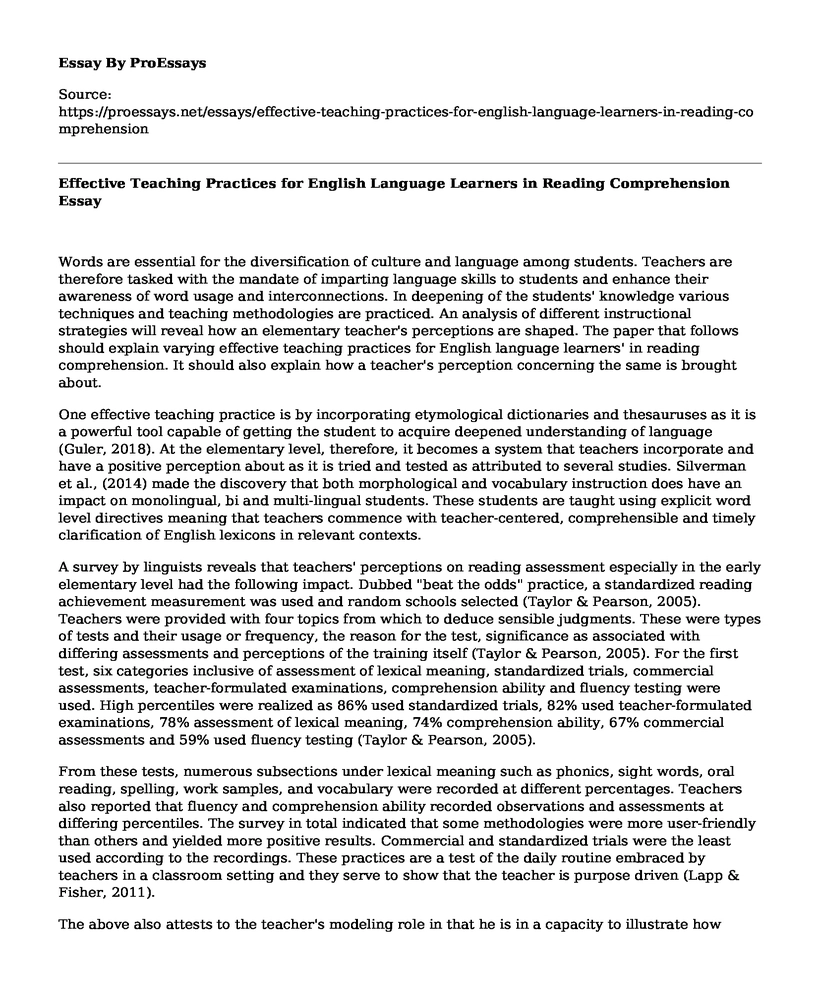Words are essential for the diversification of culture and language among students. Teachers are therefore tasked with the mandate of imparting language skills to students and enhance their awareness of word usage and interconnections. In deepening of the students' knowledge various techniques and teaching methodologies are practiced. An analysis of different instructional strategies will reveal how an elementary teacher's perceptions are shaped. The paper that follows should explain varying effective teaching practices for English language learners' in reading comprehension. It should also explain how a teacher's perception concerning the same is brought about.
One effective teaching practice is by incorporating etymological dictionaries and thesauruses as it is a powerful tool capable of getting the student to acquire deepened understanding of language (Guler, 2018). At the elementary level, therefore, it becomes a system that teachers incorporate and have a positive perception about as it is tried and tested as attributed to several studies. Silverman et al., (2014) made the discovery that both morphological and vocabulary instruction does have an impact on monolingual, bi and multi-lingual students. These students are taught using explicit word level directives meaning that teachers commence with teacher-centered, comprehensible and timely clarification of English lexicons in relevant contexts.
A survey by linguists reveals that teachers' perceptions on reading assessment especially in the early elementary level had the following impact. Dubbed "beat the odds" practice, a standardized reading achievement measurement was used and random schools selected (Taylor & Pearson, 2005). Teachers were provided with four topics from which to deduce sensible judgments. These were types of tests and their usage or frequency, the reason for the test, significance as associated with differing assessments and perceptions of the training itself (Taylor & Pearson, 2005). For the first test, six categories inclusive of assessment of lexical meaning, standardized trials, commercial assessments, teacher-formulated examinations, comprehension ability and fluency testing were used. High percentiles were realized as 86% used standardized trials, 82% used teacher-formulated examinations, 78% assessment of lexical meaning, 74% comprehension ability, 67% commercial assessments and 59% used fluency testing (Taylor & Pearson, 2005).
From these tests, numerous subsections under lexical meaning such as phonics, sight words, oral reading, spelling, work samples, and vocabulary were recorded at different percentages. Teachers also reported that fluency and comprehension ability recorded observations and assessments at differing percentiles. The survey in total indicated that some methodologies were more user-friendly than others and yielded more positive results. Commercial and standardized trials were the least used according to the recordings. These practices are a test of the daily routine embraced by teachers in a classroom setting and they serve to show that the teacher is purpose driven (Lapp & Fisher, 2011).
The above also attests to the teacher's modeling role in that he is in a capacity to illustrate how comprehension first occurs in his mind before transferring the same to his students. It is a fulfilling type of tutoring and the teacher's esteem is boosted and his perception positive as he assumes responsibility for the student (Fisher, Frey & Lapp, 2008).
In addition, the above allows the teacher to promote group discussions and speaking of one's native language. The importance associated is the freedom of the students to make and correct language errors. In such instances, students are able to discuss ideas in their original mother tongue and make the necessary translations to English (Stone et al., 2016).
The above analysis portrays a positive response as pertains to English language learners in the reading of the comprehension. Teachers' perceptions of the above-stated language teaching methodologies are complementary and in tandem. Their perspectives are in support of a workable stratagem as language acquisition is the end objective.
References
Fisher, D., Frey, N., & Lapp, D. (2008). Shared readings: Modeling comprehension, vocabulary, text structures, and text features for older readers. The Reading Teacher, 61(7), 548-556.
Guler, N. (Ed.). (2018). Optimizing Elementary Education for English Language Learners. IGI Global.Lapp, D., & Fisher, D. (Eds.). (2011). Handbook of Research on Teaching the English Language Arts: Co-Sponsored by the International Reading Association and the National Council of Teachers of English. Routledge.
Silverman, R. D., Proctor, C. P., Harring, J. R., Doyle, B., Mitchell, M. A., & Meyer, A. G. (2014). Teachers' instruction and students' vocabulary and comprehension: An exploratory study with English monolingual and Spanish-English bilingual students in Grades 3-5. Reading Research Quarterly, 49(1), 31-60.
Stone, C. A., Silliman, E. R., Ehren, B. J., & Wallach, G. P. (Eds.). (2016). Handbook of language and literacy: Development and disorders. Guilford Publications.Taylor, B. M., & Pearson, P. D. (Eds.). (2005). Teaching reading: Effective schools, accomplished teachers. Routledge.
Cite this page
Effective Teaching Practices for English Language Learners in Reading Comprehension. (2022, Mar 29). Retrieved from https://proessays.net/essays/effective-teaching-practices-for-english-language-learners-in-reading-comprehension
If you are the original author of this essay and no longer wish to have it published on the ProEssays website, please click below to request its removal:
- Cognitive Development Essay
- Controversy Surrounding the Paying of College Athletes
- Socioeconomic Status Affects Language Development in Girls Paper Example
- Essay on Student Affairs: Broadening Functional Areas for Student Success
- Essay Sample on NC School Report Card: Essential for Parents, Educators & Researchers
- My Journey to Self-Realization - Essay Sample
- Paper Example on Evolution of a Child's Attachment







